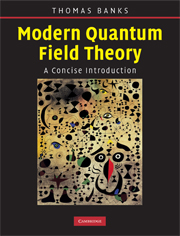Book contents
- Frontmatter
- Contents
- 1 Introduction
- 2 Quantum theory of free scalar fields
- 3 Interacting field theory
- 4 Particles of spin 1, and gauge invariance
- 5 Spin-½ particles and Fermi statistics
- 6 Massive quantum electrodynamics
- 7 Symmetries, Ward identities, and Nambu–Goldstone bosons
- 8 Non-abelian gauge theory
- 9 Renormalization and effective field theory
- 10 Instantons and solitons
- 11 Concluding remarks
- Appendix A Books
- Appendix B Cross sections
- Appendix C Diracology
- Appendix D Feynman rules
- Appendix E Group theory and Lie algebras
- Appendix F Everything else
- References
- Author index
- Subject index
9 - Renormalization and effective field theory
Published online by Cambridge University Press: 05 June 2012
- Frontmatter
- Contents
- 1 Introduction
- 2 Quantum theory of free scalar fields
- 3 Interacting field theory
- 4 Particles of spin 1, and gauge invariance
- 5 Spin-½ particles and Fermi statistics
- 6 Massive quantum electrodynamics
- 7 Symmetries, Ward identities, and Nambu–Goldstone bosons
- 8 Non-abelian gauge theory
- 9 Renormalization and effective field theory
- 10 Instantons and solitons
- 11 Concluding remarks
- Appendix A Books
- Appendix B Cross sections
- Appendix C Diracology
- Appendix D Feynman rules
- Appendix E Group theory and Lie algebras
- Appendix F Everything else
- References
- Author index
- Subject index
Summary
We are finally ready to face up to the fact that most of the expressions we write in the Feynman-diagram solution of quantum field theory are nonsensical, which is to say infinite. The purpose of this introductory section is to demonstrate the simple and general counting rules which prove that this is so, and to give the reader a conceptual orientation to the general theory of renormalization, which we will discuss in the rest of this chapter.
We will begin with the conceptual. The formalism of quantum field theory makes statements about arbitrarily short distances in space-time and arbitrarily high energies. At a given moment in history experiment will never probe arbitrarily short distances or high energies. We should expect that the formalism will have to change to fit the data as we uncover more empirical facts about short distances. This has happened before. Hydrodynamics is a field theory, but we know that at short enough distance scales it is not a good description of water. A better one is given (in principle) by the Schrödinger equation for hydrogen and oxygen nuclei interacting with electrons, and that in turn is superseded by the standard model of particle physics as we go to even shorter distances and higher energies. Yet only a fool would imagine that one should try to understand the properties of waves in the ocean in terms of Feynman-diagram calculations in the standard model, even if the latter understanding is possible “in principle.”
Information
- Type
- Chapter
- Information
- Modern Quantum Field TheoryA Concise Introduction, pp. 137 - 205Publisher: Cambridge University PressPrint publication year: 2008
Accessibility standard: Unknown
Why this information is here
This section outlines the accessibility features of this content - including support for screen readers, full keyboard navigation and high-contrast display options. This may not be relevant for you.Accessibility Information
- 1
- Cited by
